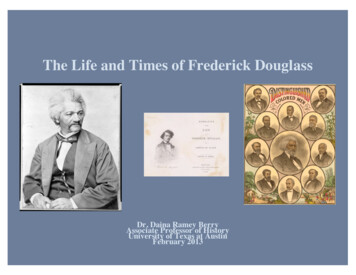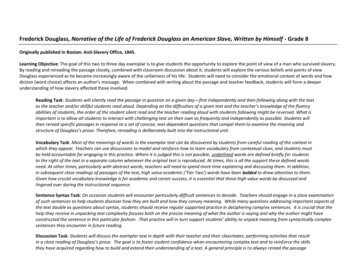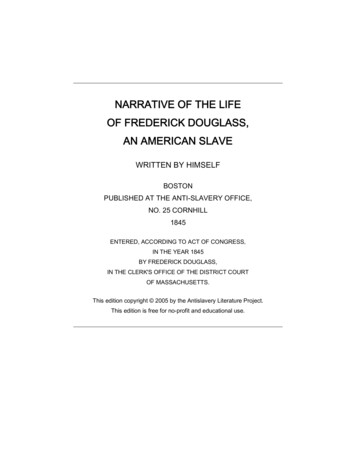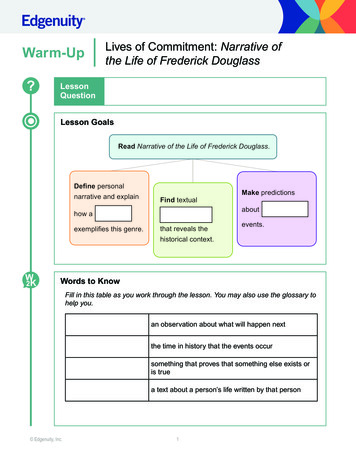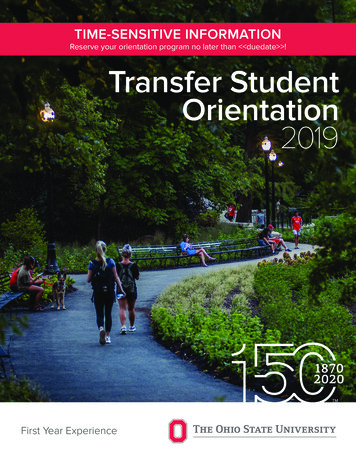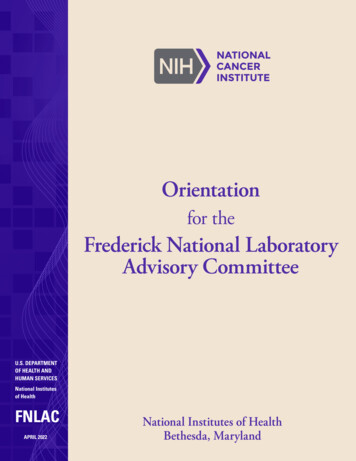
Transcription
Orientationfor theFrederick National LaboratoryAdvisory CommitteeU.S. DEPARTMENTOF HEALTH ANDHUMAN SERVICESNational Institutesof HealthFNLACAPRIL 2022National Institutes of HealthBethesda, Maryland
Orientationfor theFrederick National LaboratoryAdvisory CommitteeNational Institutes of HealthBethesda, Maryland
FOREWORDCongratulations on your recent appointment to the Frederick National Laboratory Advisory Committee(FNLAC). As you join this distinguished committee, we could not be more honored to have you working withthe National Cancer Institute (NCI).The primary task of the FNLAC is to advise the Director of the NCI and the Associate Director, FrederickNational Laboratory of Cancer Research (FNLCR), on the state of research (extramural and intramural) beingconducted at the FNLCR and to make recommendations for the best use of the FNLCR capabilities and infrastructure. Specifically, you will review new projects proposed to be performed at the FNLCR with respect tothe intrinsic merit of the projects and whether they should be conducted at the FNLCR. In addition, you willperiodically review the existing portfolio of projects at the FNLCR, evaluate their productivity and scientificimpact, help determine which of these projects should be transitioned to more conventional mechanisms ofsupport (i.e., grants, contracts, cooperative agreements), and which should be considered for termination. Asa FNLAC member, you will help to ensure that the operations at the FNLCR are open, transparent, and in thebest interests of the entire cancer research community.This briefing document has been prepared to provide new members of the FNLAC with an overview of themission, history, and activities of the FNLCR and the NCI.The first section of the book presents the NCI in the context of the total U.S. Department of Health andHuman Services (HHS) and National Institutes of Health (NIH) organization. It includes budgetaryinformation, cites current legislative statutes, and describes organizational structure, program disciplines, andmechanisms of funding used by the NCI.The second section provides a description of the FNLCR, including a timeline that chronicles theestablishment and evolution of the FNLCR and the establishment of the FNLAC. It also delineates the roles ofexternal committees that advise the NCI in the conduct of its activities.We are pleased to provide you with this FNLAC Orientation Book and hope you will refer to it in fulfillingyour responsibilities as a member of the FNLAC.Paulette S. Gray, Ph.D.DirectorDivision of Extramural ActivitiesNational Cancer InstituteNCI FNLAC Orientation Bookiii
ivNCI FNLAC Orientation Book
TABLE OF CONTENTSPagePageFOREWORD. iiiOffice of Advocacy Relations (OAR). 18Office of Communications and PublicLiaison (OCPL). 18Office of Government and CongressionalRelations (OGCR). 18Office of HIV and AIDS Malignancy(OHAM). 18Office of Acquisitions (OA). 18Office of Budget and Finance (OBF). 18Office of Grants Administration (OGA). 18Office of Management Policy andCompliance (OMPC). 18NCI Programs and Activities. 18NCI Cancer Programs. 19Cancer Causation. 19Detection and Diagnosis. 19Treatment. 19Cancer Biology. 19Cancer Prevention and Control. 19NCI Resources. 19Cancer Centers. 19Specialized Programs of ResearchExcellence (SPORE). 20Comprehensive MinorityInstitution/Cancer Center Partnership. 20Research Manpower Development. 20NCI Funding Mechanisms. 20U.S. DEPARTMENT OF HEALTH AND HUMANSERVICES (HHS). 1Mission and Organization . 1THE NATIONAL INSTITUTES OF HEALTH . 1Mission, Organization, and History. 1Overview of NIH History . 1THE NATIONAL CANCER INSTITUTE. 10NCI Mission. 10NCI and the National Cancer Program. 10NCI Legislative Authority. 11Bypass Budget. 11NCI Organizational Structure. 12NCI Extramural Divisions. 12Division of Cancer Biology (DCB). 12Division of Cancer Control andPopulation Sciences (DCCPS). 12Division of Cancer Treatment andDiagnosis (DCTD). 12Division of Cancer Prevention (DCP). 12Division of Extramural Activities (DEA). 15NCI Intramural Divisions and Centers. 15Division of Cancer Epidemiology andGenetics (DCEG). 15Center for Cancer Research (CCR). 15NCI Offices and Centers Within theOffice of the Director. 15NCI Center for Biomedical Informaticsand Information Technology (CBIIT). 15Center for Research Strategy (CRS). 15Center to Reduce Cancer HealthDisparities (CRCHD). 16Center for Strategic ScientificInitiatives (CSSI). 16Small Business Innovation Research(SBIR) Development Center. 16.Center for Cancer Training (CCT). 16Coordinating Center for ClinicalTrials (CCCT). 16Center for Cancer Genomics (CCG). 16Center for Global Health (CGH). 17Technology Transfer Center (TTC). 17NCI-Frederick Office of ScientificOperations. 17Office of Cancer NanotechnologyResearch (OCNR). 17Office of Cancer Clinical ProteomicsResearch (OCCPR). 17Office of Cancer Centers (OCC). 17FREDERICK NATIONAL LABORATORY FORCANCER RESEARCH (FNLCR)—FEDERALLYFUNDED RESEARCH AND DEVELOPMENTCENTER (FFRDC). 23Overview. 23Frederick National Laboratory for CancerResearch (FNLCR). 23Chronological History of the FNLCR andFNLAC. 24FNLCR Facilities. 29FNLCR Budget. 31FNLCR Scientific Support. 32FNLCR Support of NCI Divisions, Offices,and Centers. 33Additional FNLCR–Supported Programsand Laboratories. 34FNLCR National Programs and Initiatives. 36RAS Initiative. 36Human Papillomavirus (HPV) SerologyLaboratory. 36Cryo-Electron Microscopy (EM) Facility. 36Beau Biden Cancer Moonshot . 37Accelerating Therapeutics forOpportunities in Medicine (ATOM). 37NCI FNLAC Orientation Bookv
PageCOVID-19 Research.37Serological Sciences Network (SeroNet) .37NIAID COVID-19 Clinical Trials .38Other Collaborations.38NCI ADVISORY BOARDS, COMMITTEES,AND REVIEW GROUPS .39.Presidentially Appointed Panel and Board .39Program Advisory Boards and Committees .39NCI Review Groups and Panels .40NCI Leadership . 40FREDERICK NATIONAL LABORATORYADVISORY COMMITTEE (FNLAC). 41Background. 41FNLAC Charter. 41FNLAC Legislative Authority . 41Membership and Designation . 41Description of Duties . 41FNLAC Meetings . 42Conflict of Interest and Ethics Rules forFNLAC Members . 42FNLAC Subcommittees and WorkingGroups . 42RAS Oversight Subcommittee. 42National Cryo-Electron Microscopy (EM)Facility Oversight Subcommittee . 43Ad Hoc RAS Working Group. 43Ad Hoc National Cryo-EM FacilityOversight Working Group. 43Ad Hoc NCI–DOE Collaborations WorkingGroup. 43APPENDICESAPPENDIX A: President’s Cancer Panel . 45APPENDIX B: National Cancer AdvisoryBoard . 46.APPENDIX C: Board of ScientificAdvisors. 49APPENDIX D: Board of ScientificCounselors. 52APPENDIX E: Clinical Trials andTranslational Research AdvisoryCommittee (CTAC) . 56.APPENDIX F: Frederick NationalLaboratory Advisory Committee . 59APPENDIX G: NCI Council of ResearchAdvocates . 61APPENDIX H: NCI Scientific ProgramLeadership Committee . 62.APPENDIX I: Summary of Ethics Rulesfor Special Government EmployeesServing on Advisory Committees. 64.APPENDIX J: Related Documents . 67APPENDIX K: Websites of Interest . 68.APPENDIX L: List of Abbreviations . 71EXHIBITSI. U.S. Department of Healthand Human Services .2II. National Institutes of Health .6III. NIH FY2019–2021 Institute Funding .7IV. NIH Facilities Map .8V. The National Cancer Institute .13VI. The National Cancer Institute(Continued) .14VII. NCI Funding History, FY2010–2020.21VIII. Research Program Grantsand Dollars Awarded, FY2010–2020 .21IX. Research Funding for VariousResearch Areas, FY2014–2019.22X. NCI Frederick Campus Map .30XI. Frederick Advanced TechnologyResearch Facility (ATRF)—Frederick, MD .31XII. FNLCR Obligations .32viPageNCI FNLAC Orientation Book
U.S. DEPARTMENT OF HEALTH AND HUMANSERVICES (HHS)Mission and OrganizationThe mission of the U.S. Department of Healthand Human Services (HHS) is to enhance thehealth and well-being of Americans by providingfor effective health and human services and byfostering strong, sustained advances in the sciencesunderlying medicine, public health, and socialservices. The HHS consists of the Office of theSecretary, which provides leadership; the ProgramSupport Center, which provides centralizedadministrative support; and 11 operating divisions, including eight agencies in the U.S. PublicHealth Service (PHS), and three human services.The Office of the Secretary (OS), the chief policyofficer and general manager of HHS, administersand oversees the organization, its programs, andits activities. The deputy secretary and severalassistant secretaries and offices support the OS.The operating Divisions of HHS include:The ACF supports a variety of initiatives thatpromote the economic and social well-being offamilies, children, individuals, and communities.The ACL works to maximize the independence,well-being, and health of older adults, peoplewith disabilities across the lifespan, and theirfamilies and caregivers. The CMS manages healthinsurance programs. NIH, AHRQ, ATSDR, CDC,FDA, HRSA, IHS, and SAMHSA are all devoted topublic health and compose PHS. (See Exhibit I forHHS Organization).THE NATIONAL INSTITUTESOF HEALTHMission, Organization, and History Administration for Children and Families(ACF) Administration of Community Living (ACL) Agency for Healthcare Research and Quality(AHRQ) Agency for Toxic Substances and DiseaseRegistry (ATSDR) Centers for Disease Control and Prevention(CDC) Centers for Medicare and Medicaid Services(CMS)NIH’s mission is to uncover new knowledge thatwill lead to better health for everyone. The NIHworks toward that mission by conducting researchin its own laboratories; supporting the researchof non-Federal scientists in universities, medicalschools, hospitals, and research institutionsthroughout the country and abroad; helping totrain research investigators; and fostering communication of medical information. The NIH iscomposed of the Office of the Director, 20 Institutes,six Centers (four of which have funding authority),and the National Library of Medicine with 75buildings in a campus-like environment locatedon more than 300 acres in Bethesda, Maryland. Anorganizational chart for the NIH is presented inExhibit II. The NIH budget has grown from 300in 1887, when the NIH was a one-room Laboratoryof Hygiene, to 42.9 billion in 2021 (Exhibit III).A guide to the Bethesda campus is provided inExhibit IV. Food and Drug Administration (FDA)Overview of NIH History Health Resources and ServicesAdministration (HRSA) Indian Health Service (IHS) National Institutes of Health (NIH) Program Support Center (PSC) Substance Abuse and Mental HealthServices Administration (SAMHSA)The NIH is a component of the Public HealthService (PHS) of HHS. The PHS traces its originto “An Act for the Relief of Sick and DisabledSeamen” of 1798 (Stat. L. 604), which authorizedthe establishment of marine hospitals for the careof American merchant seamen. In 1912, the PublicHealth and Marine Hospital Service became thePublic Health Service.The actual forerunner of the NIH was establishedin 1887 as the Laboratory of Hygiene, located atthe Marine Hospital of Staten Island, New York.In 1930, this laboratory was renamed the NationalInstitute of Health. The first of the presentNCI FNLAC Orientation Book1
2NCI FNLAC Orientation BookAssistant Secretary,Administrationfor Community Living(ACL)Exhibit I. U.S. Department of Health and Human Services
Institutes, the National Cancer Institute (NCI),was established in 1937 by an act of Congress.In 1938, the National Advisory Cancer Councilapproved the first awards for research trainingfellowships in cancer research. In 1948, theNational Heart Institute was established, and theNational Institute of Health became the NationalInstitutes of Health (NIH). During the years1949–2001, the NIH expanded to include 27Institutes and Centers.The following timeline chronicles the establishment and evolution of the current NIH Institutesand Centers:1798President John Adams signed “an act forthe relief of sick and disabled Seamen,”which led to the establishment of theMarine Hospital Service.1803The first permanent Marine Hospitalwas authorized to be built in Boston,Massachusetts.1836The Library of the Office of the SurgeonGeneral of the Army was established.1870President Grant signed a law establishinga “Bureau of the U.S. Marine HospitalService” within the Treasury Department.This Bureau, headed by a SupervisingSurgeon (later Surgeon General), wasgiven central control over the hospitals.1887The Laboratory of Hygiene at the MarineHospital in Staten Island, New York, wasestablished for research on cholera andother infectious diseases.1891The Laboratory of Hygiene wasre-designated the Hygienic Laboratoryand moved from Staten Island to theMarine Hospital Service headquarters inWashington, DC.1902The Advisory Board for the HygienicLaboratory was established; later becamethe National Advisory Health Council.Act of Congress changed the name ofthe Marine Hospital Service to the PublicHealth and Marine Hospital Service.Hygienic Laboratory was authorized byCongress to regulate laboratories thatproduced “biologicals.” The HygienicLaboratory was expanded to fourdivisions: Bacteriology and Pathology,Chemistry, Pharmacology, and Zoology.1912The Public Health and Marine HospitalService was renamed Public HealthService (PHS).1922The Library of the Office of the SurgeonGeneral was renamed Army MedicalLibrary.1930The Hygienic Laboratory was renamedthe National Institute of Health (NIH).Congress authorized construction of twobuildings for the NIH and a system offellowships.Congress authorized the establishment ofthe National Cancer Institute (NCI) andthe awarding of research grants. RockyMountain Laboratory became part ofthe NIH. The National Advisory CancerCouncil held its first meeting.19371938The NIH was moved to land donated byMr. and Mrs. Luke I. Wilson, located inBethesda, Maryland. Cornerstone for theShannon Building was laid.1939The Public Health Service (PHS) becamepart of a newly created Federal SecurityAgency; until that time, it was part of theTreasury Department.1946The Division of Research Grants (DRG)was established to process NIH grants andfellowships to non-Federal institutionsand scientists. (Originally establishedas the Research Grants Office, it wasrenamed the Research Grants Divisionand, finally, the Division of ResearchGrants.)1948The National Heart Institute (NHI)was authorized. Several laboratories(including Rocky Mountain Laboratory)were regrouped to form the NationalMicrobiological Institute. TheExperimental Biology and MedicineInstitute and the National Institute ofDental Research were established. TheNational Institute of Health became theNational Institutes of Health.1949The Mental Hygiene Program of the PHSwas transferred to the NIH and expandedto become the National Institute of MentalHealth.NCI FNLAC Orientation Book3
1950The “Omnibus Medical Research Act”authorized the establishment of theNational Institute of NeurologicalDiseases and Blindness (NINDB), as wellas the National Institute of Arthritis andMetabolic Diseases (NIAMD). The latterabsorbed the Experimental Biology andMedicine Institute.1968The John E. Fogarty International Center(FIC) for Advanced Study in the HealthSciences was created. The Bureau ofHealth Manpower and the NLM becamepart of the NIH. The National EyeInstitute (NEI) was created. The NationalInstitute of Neurological Diseases andBlindness was renamed the NationalInstitute of Neurological Diseases andStroke.1953The PHS became part of the newly createdDepartment of Health, Education, andWelfare. The Clinical Center opened.1969The Division of Environmental HealthSciences was renamed the NationalInstitute of Environmental Health Sciences(NIEHS). The National Heart Institute wasrenamed the National Heart and LungInstitute.1972The Armed Forces Medical Library wasrenamed the National Library of Medicine(NLM) and placed in the PHS.The National Institute of Arthritis andMetabolic Diseases was renamed theNational Institute of Arthritis, Metabolism,and Digestive Diseases (NIAMDD).19741957The Center for Aging Research wasestablished.The National Institute on Aging (NIA)was created.19751958The Division of General Medical Scienceswas created. The Center for AgingResearch was transferred from theNational Heart Institute to the Division ofGeneral Medical Sciences.The National Institute of NeurologicalDiseases and Stroke was renamed theNational Institute of Neurological andCommunicative Disorders and Stroke(NINDS).1976The Center for Research in Child Healthwas established within the Division ofGeneral Medical Sciences.The National Heart and Lung Institutewas renamed the National Heart, Lung,and Blood Institute (NHLBI).1981The National Institute of Arthritis,Metabolism, and Digestive Diseaseswas renamed the National Institute ofArthritis, Diabetes, and Digestive andKidney Diseases (NIADDK).1986The National Institute of Arthritis,Diabetes, and Digestive and KidneyDiseases was renamed the NationalInstitute of Diabetes and Digestive andKidney Diseases (NIDDK). The NationalInstitute of Arthritis and Musculoskeletaland Skin Diseases (NIAMS) was created.The Center for Nursing Research wastransferred from the Health Resourcesand Services Administration (HRSA) andrenamed the National Center for NursingResearch.195519561961The National Microbiological Institutewas renamed National Institute ofAllergy and Infectious Diseases (NIAID).The Laboratory of Biologics Controlwas renamed the Division of BiologicsStandards. The Division of ResearchServices (DRS) was created.1962The NLM was moved to the NIH campus.1963The Division of General Medical Scienceswas renamed the National Institute ofGeneral Medical Sciences (NIGMS). TheNational Institute of Child Health andHuman Development (NICHD) wascreated.1966The Division of Environmental HealthSciences was created.1967The National Institute of Mental Healthwas separated from the NIH and became aseparate bureau of the PHS.4NCI FNLAC Orientation Book
198919901992The National Institute on Deafness andOther Communication Disorders (NIDCD)was established. The National Instituteof Neurological and CommunicativeDisorders and Stroke was renamedthe National Institute of NeurologicalDisorders and Stroke (NINDS). TheNational Center for Human GenomeResearch was established. The NationalCenter for Biotechnology Information wasestablished within the NLM.The National Center for ResearchResources (NCRR) was created by consolidating the Division of Research Servicesand the Division of Research Resources.The National Institute on Alcohol Abuseand Alcoholism (NIAAA), NationalInstitute on Drug Abuse (NIDA), andNational Institute of Mental Health(NIMH) were transferred to the NIH fromthe Alcohol, Drug Abuse, and MentalHealth Administration.1993The National Center for Nursing Researchwas renamed the National Institute ofNursing Research (NINR).1995The NIH was established as an HHSOperating Division, thereby elevating it toreport directly to the Secretary of HHS.1997The National Center for Human GenomeResearch was renamed the NationalHuman Genome Research Institute(NHGRI).1998The Division of Research Grants wasrenamed the Center for Scientific Review.The National Center for Complementaryand Alternative Medicine (NCCAM)was established. The National Instituteof Dental Research was renamedthe National Institute of Dental andCraniofacial Research (NIDCR).2001The National Center on Minority Healthand Health Disparities was established.The National Institute of BiomedicalImaging and Bioengineering (NIBIB) wasestablished.2010The National Center on Minority Healthand Health Disparities was redesignatedas the National Institute on MinorityHealth and Health Disparities (NIMHD)2011The National Center for AdvancingTranslational Sciences (NCATS) wasestablished.2012NCI-Frederick Cancer Research andDevelopment Center was renamed theFrederick National Laboratory for CancerResearch (FNLCR).2014The National Center for Complementaryand Alternative Medicine became theNational Center for Complementary andIntegrative Health.NCI FNLAC Orientation Book5
6NCI FNLAC Orientation BookEunice Kennedy ShriverDivision of Program Coordination, Planning, and StrategicInitiativesImmediate Office ofthe DirectorExhibit II. National Institutes of Health
Exhibit III. NIH FY2019–2021 Funding*FUNDING (Dollars in 1,63642,940NIATOTAL*Source: NIH Office of Budget, 2021.NCI FNLAC Orientation Book7
Exhibit IV. NIH Facilities MapNB CA66.MLP 11NIH Gateway Dr.4618Employee Parking Employee Pedestrian EntryBuilding KeyBuilding 1Building 10Building 11Building 13Building 14Building 16Building 31Building 368James Shannon Building (NIH Administration)Warren Grant Magnuson Clinical Center;Mark Hatfield Clinical Research CenterCentral Utility PlantEngineering ServicesOffice of Research FacilitiesStone HouseClaude D. Pepper Building (General Office Building)Lowell P. Weicker BuildingBuilding 38Building 38ABuilding 40Building 45Building 49Building 50Building 60Building 62National Library of MedicineLister HillVaccine Research CenterNatcher Building and Conference CenterSylvio Conte BuildingStokes LaboratoriesMary Woodard Lasker CenterThe Children’s Inn at NIHNCI FNLAC Orientation Book
NIH InstitutesNational Cancer Institute (NCI) (see https://www.cancer.gov)National Eye Institute (NEI) (see https://nei.nih.gov)National Heart, Lung, and Blood Institute (NHLBI) (see https://www.nhlbi.nih.gov)National Human Genome Research Institute (NHGRI) (see https://www.genome.gov)National Institute on Aging (NIA) (see https://www.nia.nih.gov)National Institute on Alcohol Abuse and Alcoholism (NIAAA) (see https://www.niaaa.nih.gov)National Institute of Allergy and Infectious Diseases (NIAID) (see https://www.niaid.nih.gov)National Institute of Arthritis and Musculoskeletal and Skin Diseases (NIAMS)(see https://www.niams.nih.gov)National Institute of Biomedical Imaging and Bioengineering (NIBIB) (see https://www.nibib.nih.gov)Eunice Kennedy Shriver National Institute of Child Health and Human Development (NICHD)(see https://nichd.nih.gov)National Institute on Deafness and Other Communication Disorders (NIDCD)(see https://www.nidcd.nih.gov)National Institute of Dental and Craniofacial Research (NIDCR) (see https://www.nidcr.nih.gov)National Institute of Diabetes and Digestive and Kidney Diseases (NIDDK) (see https://www.niddk.nih.gov)National Institute on Drug Abuse (NIDA) (see https://www.drugabuse.gov)National Institute of Environmental Health Sciences (NIEHS) (see https://www.niehs.nih.gov)National Institute of General Medical Sciences (NIGMS) (see https://www.nigms.nih.gov)National Institute of Mental Health (NIMH) (see https://www.nimh.nih.gov)National Institute on Minority Health and Health Disparities (NIMHD) (see https://www.nimhd.nih.gov)National Institute of Neurological Disorders and Stroke (NINDS) (see https://www.ninds.nih.gov)National Institute of Nursing Research (NINR) (see https://www.ninr.nih.gov)National Library of Medicine (NLM) (see https://www.nlm.nih.gov)NIH CentersCenter for Information Technology (CIT) (see https://www.cit.nih.gov)Center for Scientific Review (CSR) (see https://public.csr.nih.gov)Fogarty International Center (FIC) (see https://www.fic.nih.gov)National Center for Advancing Translational Sciences (NCATS) (see https://ncats.nih.gov)National Center for Complementary and Integrative Health (NCCIH) (see https://nccih.nih.gov)NIH Clinical Center (see https://clinicalcenter.nih.gov)NCI FNLAC Orientation Book9
THE NATIONAL CANCER INSTITUTENCI MissionThe National Cancer Institute (NCI) is acomponent of the National Institutes of Health(NIH), one of 11 operating divisions that compose the Public Health Service (PHS) in the U.S.Department of Health and Human Services (HHS).The NCI, established under the National CancerAct of 1937, is the Federal Government’s principalagency for cancer research and training. TheNational Cancer Act of 1971 broadened the scopeand responsibilities of the NCI and created theNational Cancer Program (NCP). Over the years,legislative amendments have maintained the NCIauthorities and responsibilities and added newinformation dissemination mandates as well as arequirement to assess the incorporation of state-ofthe-art cancer treatments into clinical practice.The NCI is committed to dramatically lesseningthe impact of cancer. The NCI is the primarymeans of support for America’s cancer researchenterprise, whether in its own laboratories or inour Nation’s research universities. The NCI isdedicated to the understanding, diagnosis, treatment, and prevention of cancer for all people. TheNCI works toward this goal by providing visionto the Nation and leadership for both domesticand international NCI-funded researchers. TheNCI also works to ensure that research resultsare applied in clinical practice and publichealth-related programs to reduce the burden ofcancer for all populations.Within this framework, NCI researchers work tomore fully integrate discovery activities throughinterdisciplinary collaborations; acceleratedevelopment of interventions and new technologythrough translational research; and ensure thedelivery of these interventions for application inthe clinic and public health programs as state-ofthe-art care for all those in need.NCI and the National Cancer ProgramAs the leader of the National Cancer Program(NCP), the NCI provides vision and leadership tothe global cancer community. The NCI conductsand supports research, training, health information dissemination, and other programs withrespect to the cause, diagnosis, prevention, andtreatment of cancer, rehabilitation from cancer,and the continuing care of cancer patients andfamilies of cancer patients. Critical to the success1
six Centers (four of which have funding authority), and the National Library of Medicine with 75 buildings in a campus-like environment located on more than 300 acres in Bethesda, Maryland. An organizational chart for the NIH is presented in Exhibit II. The NIH budget has grown from 300 in 1887, when the NIH was a one-room Laboratory
